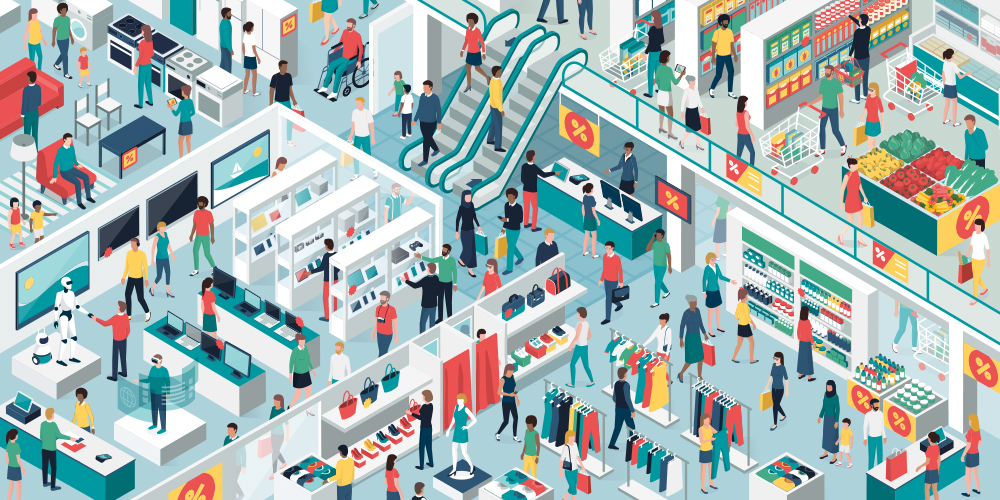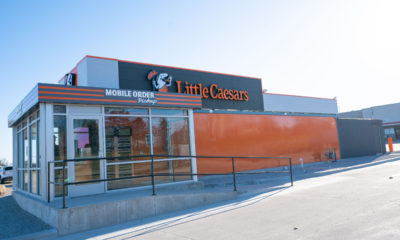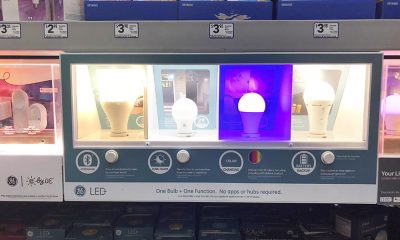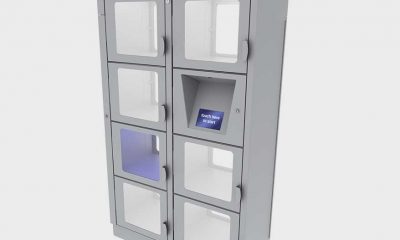We humans are locked in. We’ve got a smart fridge reminding us to pick up milk, we ask our voice assistant to check the weather, and we can access every review online about a product without having to leave the couch.
This means we’ve come to expect information fast and easily accessible. It also means we’ve gotten really good at wearing blinders to messaging when it’s coming from all angles.
So, while marketing to today’s consumer, brands must cater their path-to-purchase campaigns to dial in on how he or she wants to shop. And when it comes to designing a visual merchandising display, the objective to interrupt this busy shopper requires careful planning and thought.
Below, we detail five strategies to capture the in-store customer’s attention and interest with your display merchandisers.
Show, Don’t Tell
In the current information-verse, people are consuming data drastically different than the pre-digital age. In fact, recent studies have indicated that skim reading has become our new norm.
So, what does this tell us? People want easily-digestible information in bite-size pieces to keep their interest. This means employing digital or experiential components in a display can show what your product does or how it can benefit a consumer in a way that feels easy to comprehend.
Advertisement
Sometimes these display elements seem clear for specific verticals. If you’re selling speakers, you want customers to hear the clarity of your product by building audio capabilities into your display. It also makes sense for lighting companies to help shoppers discover the best option for their needs by utilizing working displays that showcase the look of various product selections.
But this can extend past the obvious, too.
Highly-technical products can benefit from video loops detailing simple instructions or featuring the merchandise in use. Even something as straightforward as a knife display can offer interaction so a customer can test the feel of a blade handle or the weight of the product in his or her hand.
At the end of the day, creating displays that deliver product information in palatable ways and engage a person’s senses will highlight a brand’s advantages much better than asking customers to take their word for it.
Let’s Be Clear
More than 65% of people are visual learners, which means your product merchandising needs to be organized in a way that feels clear and aims to educate. Pretty straightforward, right?
But organization can go even deeper. Yes, clean lines, coordinated colors and lack of clutter is important when making a positive impact, but proper categorization can really benefit your sales.
Advertisement
Let’s take most paint displays as an example. Often, the bulk of paint chips are shown together by color family, but sometimes these same displays will have special sections on the unit devoted to various collections, too.
These areas aim to inform shoppers about complementary colors or trending hues for various rooms in the house. Sometimes the section might highlight colors to invoke a specific mood or they might leverage a celebrity’s clout by pinpointing colors from his or her exclusive line.
And while each paint brand will decide what sections to highlight based on their target customer’s demographics, the companies recognize their patrons are looking for additional guidance when choosing wall colors and provide a solution to help them feel in control of the process while making knowledgeable decisions.
As brands look to best display their merchandise, they’ll want to investigate beyond the apparent methods to organize in search of ways to answer additional questions from their potential buyers.
Staying Relevant
I identify as many things – a marketer, a mom, a Packer football enthusiast – which means brands have countless avenues to pique my interest at different times of the year. If I missed your product display during the summer, you might easily hook me with back-to-school messaging come fall.
An easy way to make sure your marketing stays current and seasonally appropriate is to incorporate changeable visuals into your display with magnetic graphics.
Advertisement
Not only do updatable graphics speak to a variety of audiences depending on holidays or seasons, but they’re also perfect for displays that will be in multiple locations that target different audiences. For instance, a merchandising display for an activity tracker might be found in sporting goods stores as well as department stores, both of which might use different graphics to appeal to the audience that frequents those settings.
Changing up imagery on a display can also save on costs as a brand’s marketing initiatives change throughout the year. It keeps messaging fresh without the large expense of a brand-new display.
Endless Aisles
Brick-and-mortar is currently going through a rebirth with retailers pressed to implement strategies that provide customers with a well-rounded experience of a brand – both in-store and online. The same can be said for visual merchandising.
Successful displays not only showcase product and educate consumers, but many incorporate digital elements. A popular feature is the endless aisle, accessible through an interactive kiosk on the display or within a shop-in-shop.
Imagine: your visual merchandising display just did the hard work. Your customer is standing in front of your product and has decided to purchase. However, the retailer doesn’t carry your full line of colors or they’re out of the specific size the customer needs.
Enter an endless aisle opportunity to keep the momentum going on your customer’s impulse decision. If she were to leave with the intent of later buying online, you run the risk of her talking herself out of the decision. Even worse, she could decide a competitor has a similar enough product with better color options available in-store.
Allowing for special orders with endless aisle options provides another avenue to sell product when and where your customer is actively going through the buying process.
Back to the Basics
Sometimes the art of grabbing a shopper’s attention can really be credited to delivering the basics. Good, effective signage. Proper lighting. Impactful messaging.
Sounds straightforward, but focusing your efforts on these foundational elements will lay the right groundwork for your merchandising display.
Consider what works best for your merchandiser. Do you have a shop-in-shop program? A circular halo sign can lure customers to your area from across a store. Looking to stand out on an otherwise dull shelf? Lighting adds life (and the perfect spotlight) to your product.
Messaging should be succinct, on-brand and helpful. Remember, you’re appealing to a new culture of skim readers who want information quickly.
Land Your Loyalists
At the end of the day, you know your target customer intimately, so your relevant merchandise is already set to succeed. With extra consideration paid to your path-to-purchase strategy, you’ll help your future brand loyalists discover that product easily.


 Headlines1 week ago
Headlines1 week ago
 Headlines1 week ago
Headlines1 week ago
 Headlines1 week ago
Headlines1 week ago
 Designer Dozen2 weeks ago
Designer Dozen2 weeks ago
 Headlines6 days ago
Headlines6 days ago
 Headlines3 days ago
Headlines3 days ago
 Headlines2 weeks ago
Headlines2 weeks ago




















